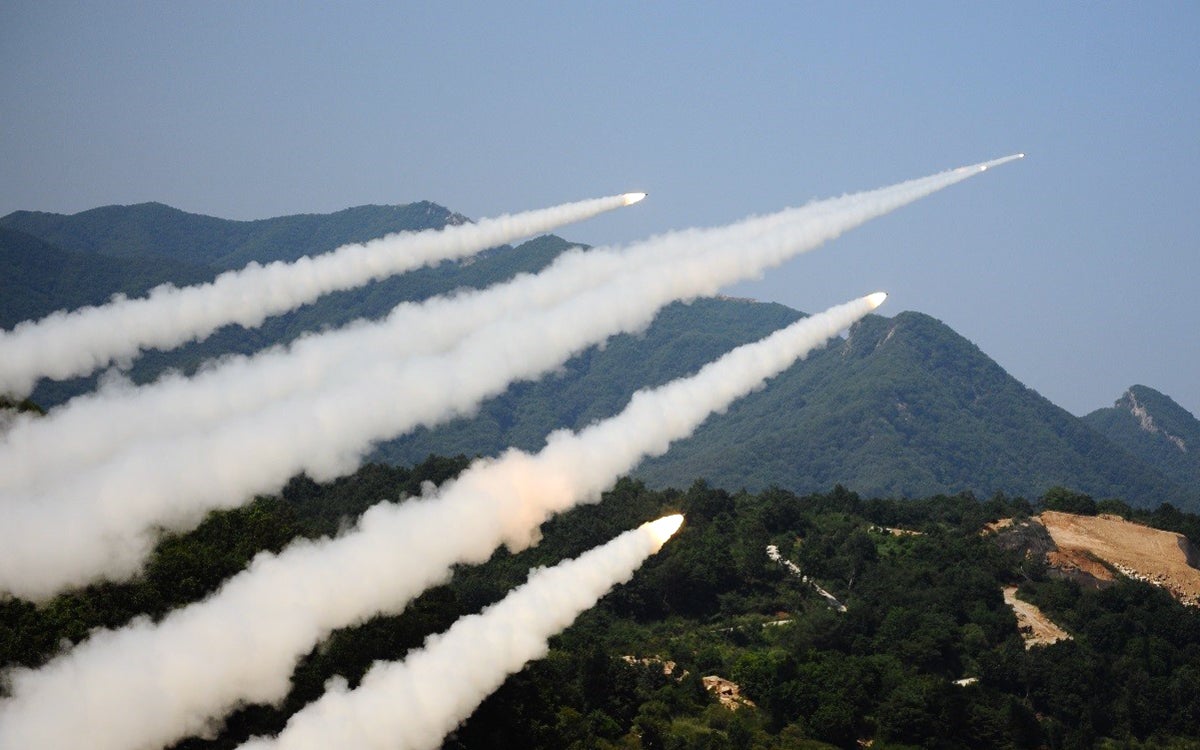
The United States is faced with peer competitors—China and Russia—seeking to alter the strategic landscape and supplant U.S. influence in key regions.1 Recognizing that they were outmatched militarily by the United States (although the gap is closing), China and Russia focused on developing capabilities to prevent the U.S. military from stopping their potential aggression through a strategy of anti-access/area-denial (A2/AD). Through a layered combination of long-range rockets and missiles, cyber attack, advanced air defense and other means, they seek the ability to delay U.S. military access to key regions until they have achieved their objectives in a fait accompli.
WHY IS THE ARMY PRIORITIZING LRPF?
The U.S. military response to the emergence of potential threats from revisionist powers spans many areas—modernization, operational concepts, doctrine and force posture. In October 2017, based on the demand signal from the combatant commanders (COCOMs) of both U.S. European Command (USEUCOM) and U.S. Pacific Command (renamed U.S. Indo-Pacific Command, i.e., USINDOPACOM, in 2018), the Army designated Long-Range Precision Fires (LRPF) as its number-one modernization priority.2
Since that time, the Army has consistently and rigorously pursued development of the LRPF capability demanded by the COCOMs across multiple lines of effort: modernization; its new Multi-Domain Operations (MDO) concept; a testing and experimental campaign of learning; and a 21st century talent management program to produce Soldiers and civilians with the skills, talents and character needed to prevail in competition and conflict. While the rationale for these initiatives may seem self-evident and was validated by the Secretary of Defense and the Chairman of the Joint Chiefs of Staff (CJCS), some misunderstanding still exists within the U.S. Defense community regarding the importance of Army LRPF—not to the Army, but to the joint force commanders who are dependent upon them.3
WHAT IS THE MILITARY PROBLEM?
U.S. military forces are outgunned and outranged.4 The 2019 dissolution of the Intermediate Nuclear Forces (INF) Treaty between the United States and Russia, which prohibited indirect fire systems with ranges between 500 and 5,500 kilometers, altered the strategic landscape. Russia, long in violation of the prohibition on these weapon systems, and China, not a signatory to the treaty, had both already fielded multiple rocket and missile systems with ranges well beyond 500 kilometers.
Belated recognition of both Russian and Chinese land forces’ predominance in intermediate and long-range rocket and missile systems—an essential component of both Chinese and Russian A2/AD complexes—and removal of the INF constraint validated the decision to pursue LRPF in Army modernization efforts in order to address this gap as part of its contribution to the joint fight.
WHAT IS THIS DISCUSSION ABOUT AND WHAT IS IT NOT ABOUT?
It is about rapidly converging effects across all domains, both through temporarily opened windows and through linking any sensor with the best shooter available, all while being controlled by the right headquarters. It is not about surface-based versus air-delivered, or manned versus unmanned, or Army versus Air Force versus Navy; it is about providing complementary options to joint force commanders and creating multiple dilemmas for potential adversaries.
HOW RELEVANT ARE LAND-BASED FORCES IN THE INDOPACOM AOR?
While the essential contribution of ground forces to the defense of Europe is well understood, the importance of land-based forces in the Indo-Pacific area of responsibility (AOR) is often under-recognized in terms of the benefits they provide to the United States and host countries. Despite characterizations of the Indo-Pacific as being a primarily maritime and air-focused theater, the land domain is more significant than many realize. The Indo-Pacific has six of the world’s 10 largest armies, and 21 of its 27 nations’ Chiefs of Defense are Army officers. This army-to-army connection can support the strengthening of partnerships and alliances as called for by the National Defense Strategy (NDS). This “landpower network is DOD’s foundation for competition, creating inroads and maneuver space for joint and whole-of-government strategic engagement,” according to the Acting Secretary of the Army and Army Chief of Staff in testimony on 5 May 2021.5 This competitive advantage can reassure allies and reduce the likelihood of conflict.
While discussion of security in the Indo-Pacific region tends to focus on scenarios pertaining to Taiwan or the South China Sea, if either of these potential flashpoints were to cross the threshold to great-power conflict, it would be unwise to assume that it would remain localized. It is quite possible that the conflict would be waged across the AOR and even globally in some form. (It also is worth noting that China shares borders with 14 countries, spanning almost 14,000 miles, and has territorial disputes with nearly all of them.)
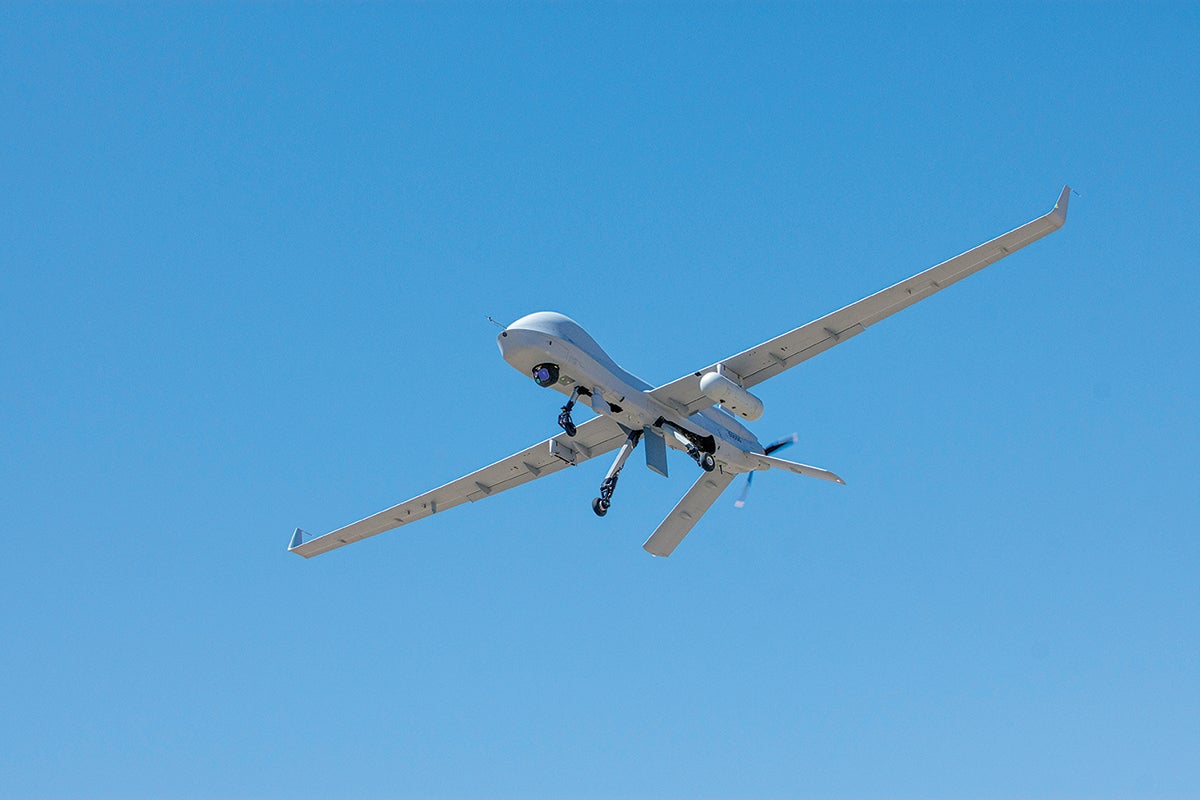 Soaring through the sky, an Extended-Range Multi-Purpose Unmanned Aircraft System simulates attacks on enemy targets during Project Convergence 20 at Yuma Proving Ground, Arizona, 15 September 2020 (U.S. Army photo by Specialist Jovian Siders).
Soaring through the sky, an Extended-Range Multi-Purpose Unmanned Aircraft System simulates attacks on enemy targets during Project Convergence 20 at Yuma Proving Ground, Arizona, 15 September 2020 (U.S. Army photo by Specialist Jovian Siders).Of the five competitors and adversaries named in the NDS, four—China, North Korea, Russia, and terrorist groups—are active in the Indo-Pacific region. Deterring aggression in this region requires establishing a forward-deployed defense-in-depth posture. Protecting U.S. interests from China and Russia will require additional investment in the submarine fleet; intelligence, surveillance, and reconnaissance (ISR) assets; air defense; long-range strike platforms; and long-range ground-based fires [emphasis added].6
Regarding USEUCOM and the Korean Peninsula, the Commission stated:
The United States will need capacity enhancements in the Army. More armor, long-range fires [emphasis added], engineering, and air-defense units are required to meet the ground-heavy challenges posed by Russia in Eastern Europe and while maintaining a robust deterrent to aggression on the Korean Peninsula.7
The increasing demand signal for land-based long-range fires continues from both USINDOPACOM and USEUCOM. In testimony to the Senate Armed Services Committee on 9 March 2021, Admiral Phil Davidson, Commander of USINDOPACOM, stressed the importance of land-based LRPF:
USINDOPACOM requires highly survivable, precision-strike fires featuring increased quantities of ground-based missiles and improved air and long-range naval fires capable of ranges over 500 km [emphasis added]. These fires must be supported by electronic warfare, space, cyber, and over-the-horizon radar capabilities. They must also be operationally decentralized and geographically distributed to provide a credible, offensive, and conventional deterrent to assure U.S. freedom of action.8
Underscoring its reliance upon LRPF, USINDOPACOM requested $408 million for Fiscal Year (FY) 2022 and $2.91 billion for FY2023–FY2027 for land-based “highly survivable, precision-strike fires that can support the air and maritime maneuver from distances greater than 500 km” as part of the Pacific Deterrence Initiative.9
WHAT DO LAND-BASED FIRES CONTRIBUTE TO THE JOINT FORCE AND THE NATION?
LRPF provide joint force commanders and national leadership with options in competition, crisis and conflict. Strategically-postured LRPF can support deterrence, provide 24/7 counterfire capability and can strike land and maritime targets without putting pilots or aircraft at risk. It can reassure allies and partners that the United States is committed to their defense and signal U.S. resolve to potential adversaries. (Although deterrence is ultimately dependent on an adversary’s decisionmaking, LRPF may be less destabilizing in a crisis than joint systems with a nuclear role since LRPF is not nuclear-capable.10) LRPF provides flexible options through Dynamic Force Employment (DFE)—the goal of which is to maneuver U.S. forces in peacetime to be “strategically predictable for our allies and operationally unpredictable for any adversary.”11 In conjunction with other service joint fires capabilities, LRPF can support deterrence by having the capability to penetrate layers of enemy A2/AD efforts by providing both offensive and defensive fires.
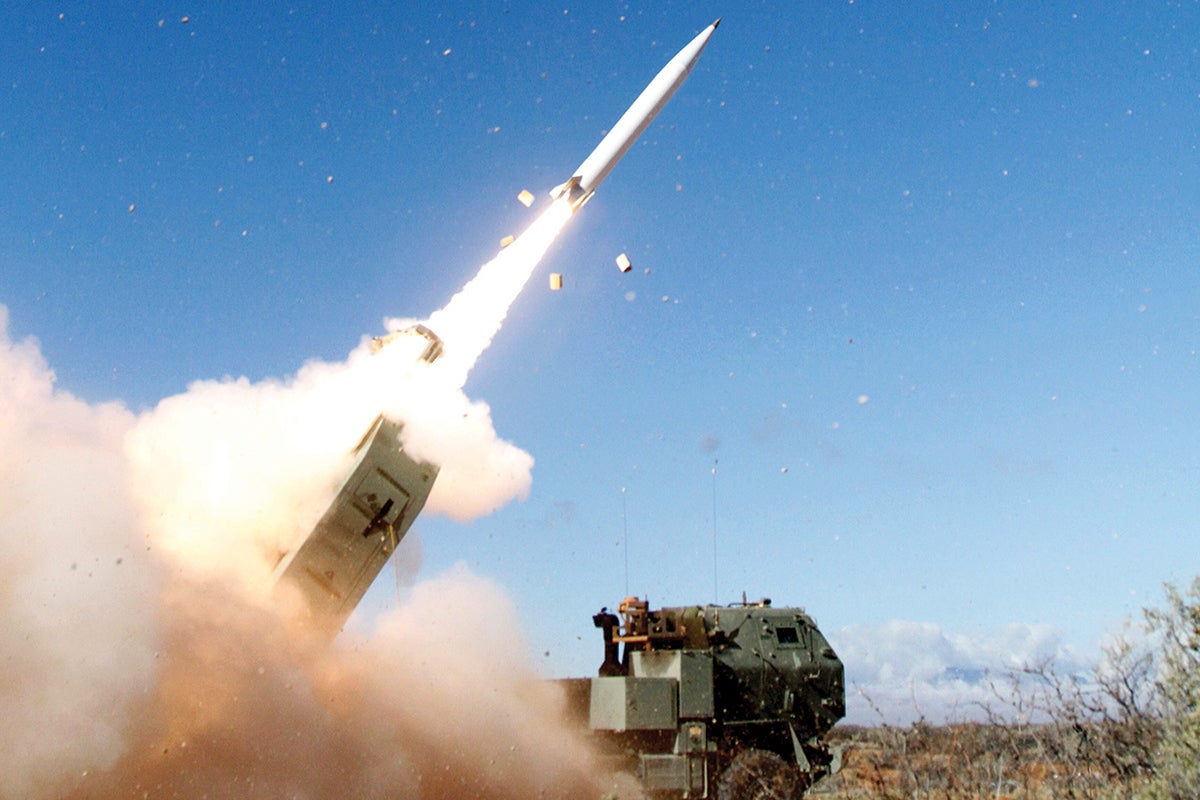 The Precision Strike Missile, compatible with both the M270A1 Multiple Launch Rocket System and M142 High-Mobility Artillery Rocket System (HIMARS), doubles the rate of fire of the MGM-140 Army Tactical Missile System (photo courtesy of Lockheed Martin).
The Precision Strike Missile, compatible with both the M270A1 Multiple Launch Rocket System and M142 High-Mobility Artillery Rocket System (HIMARS), doubles the rate of fire of the MGM-140 Army Tactical Missile System (photo courtesy of Lockheed Martin).WHAT ARE THE ARMY LRPF SYSTEMS?
The U.S. Army’s top modernization priority since 2017, LRPF consists of four signature programs being developed under the direction of the Army Futures Command (AFC) cross functional team (CFT) for LRPF. These programs are: Extended-Range Cannon Artillery (ERCA); Precision Strike Missile (PrSM); Strategic Long-Range Cannon (SLRC); and the Long-Range Hypersonic Weapon (LRHW). Other LRPF initiatives include conversion of a Navy Standard Missile (SM)-6 battery by 2023 and Tomahawk missiles to engage moving targets, both on land and at sea, at ranges from 500 to 1500 km.12
The LRPF CFT Director, Brigadier General John Rafferty, describes the approach his team uses in its assessment of viable options by answering three questions: 1) Does it meet requirements for range and precision, i.e., Can we do it?; 2) Does operational analysis demonstrate payoff, i.e., Should we do it?; and 3) What is the operational feedback from warfighter exercises regarding doctrine and organizational structure, i.e., How should we do it? The operational analysis must be rigorous and be able to hold up under scrutiny from the Office of the Secretary of Defense (OSD) Cost Assessment and Program Evaluation (CAPE) office, which will be influential in the determination of which systems merit support from a limited pool of DoD resources.13
ERCA. The ERCA is intended to hit point targets 70 kilometers away—more than twice the 30 kilometer range of the M-109A7 155 mm howitzer. It consists of the rocket-boosted XM1113 shell and a longer howitzer barrel (58 caliber versus the current 30 caliber) adapted to the current M-109A7 Paladin system, which increases the projectile’s velocity before exiting the muzzle. Plans call for an 18-gun battalion to enter service in 2023.14
PrSM. The PrSM is a surface-to-surface, all-weather, precision-strike guided missile, fired from both the M270A1 Multiple Launch Rocket System (MLRS) and M142 High-Mobility Artillery Rocket System (HIMARS).15 As the replacement for the MGM-140 Army Tactical Missile System (ATACMS), PrSM doubles ATACMS’ current rate-of-fire with two missiles per launch pod. It is designed to attack threat air defense systems, missile launchers, command and control (C2) nodes, troop assembly/staging areas and high-payoff targets throughout the battlefield at ranges of more than 500 kilometers.16
SLRC. Perhaps the most controversial of the LRPF systems, the Army is examining the feasibility of developing a cannon that can fire a projectile at hypersonic speeds up to 1,000 miles to engage air defense, artillery and missile systems and C2 targets.17 The SLRC is comprised of a cannon, prime mover and trailer; it also has projectiles that are capable of delivering massed fires at strategic ranges.18 The SLRC battery will include four cannons and heavy equipment transporters for the battery’s other equipment.19
LRHW. In 2019, OSD directed the Army to develop a hypersonic weapon system. (Hypersonic weapons can fly at five times the speed of sound and operate at varying altitudes, making them much more difficult to intercept than missiles that have a ballistic trajectory.) Through a joint agreement on design, development, testing and production with the Navy, Air Force and Missile Defense Agency, the Army is working to field hypersonic weapon systems using a Common Hypersonic Glide Body (C-HGB). The Navy leads design of the C-HGB; the Army leads production and building of a commercial industrial base. This approach enables the services to leverage one another’s technologies, while tailoring them to meet specific requirements for air, land and sea.20 The Army plans to field a prototype long-range hypersonic weapon battery by FY2023.21
IS ARMY LRPF AN UNNECESSARY REDUNDANCY?
Emerging threats are multi-domain in nature and require a multi-domain response to present adversaries with a host of simultaneous dilemmas. This is why the joint force is pursuing the Joint All-Domain Operations (JADO) Concept, which, according to General Hyten, the Vice Chairman of the Joint Chiefs of Staff (VCJCS), “succeeds if all of the force can apply fires wherever they happen to be, wherever the target is, whatever the lines of conflict.”22
The Joint Warfighting Concept (JWC) calls for all the services to be able to conduct the long-range strike mission. “Everything [now] is about lines,” he said. “But in the future, those lines are eliminated, which means an Army capability can have on its own platform, the ability to defend itself or strike deep into an adversary area of operations. A naval force can defend itself or strike deep. The Air Force can defend itself or strike deep. The Marines can defend themselves or strike deep.”23
According to the VCJCS and COCOMs, land-based, deep-fires capabilities are important to the joint force both today and on the hyper-speed battlefield envisioned in the JWC. In a denied or contested environment, opening windows of opportunity, even temporarily, will require complementary standoff capabilities. A conflict between peer competitors demands a 24/7 immediate deep-strike capability that is only achievable by integrating the delivery of air, ground and maritime-delivered munitions.
Peer adversaries likely would significantly outnumber U.S. and allied forces at the outset of a conflict far closer to their homeland than ours. A joint force capability to attack key targets with air, sea and land-based fires at range presents potential adversaries with a far more complex dilemma than if there were only a single option through which to attack them.
As former U.S. Army Pacific Commander General Robert Brown, USA, Ret., observes “the one-dimensional thinking of Cold War warfighting is obsolete—as is service parochialism. No one service, ally, or capability can go it alone without unacceptable strategic risk.”24 The battlespace of multi-domain conflict is ubiquitous. Force capabilities must be complementary and interconnected across all warfighting domains and is the premise underlying the Joint All-Domain C2 (JADC2) concept.
Defense and missile defense expert at the Center for Strategic and International Studies Tom Karako cautions, “Heed not the siren call that says that only one service or domain or capability will service the set of strike missions, plural . . . . That siren has a beautiful voice. But she deceives.”25 As the VCJCS said, “You want each service to bring those long-range fires.”26 As Air Force Deputy Chief of Staff for Strategy, Integration and Requirements, Lieutenant General Clint Hinote observes, “One interesting thing about possible war with a peer competitor is you’re pretty agnostic as to where the fires come from; you just need the fires.”27
Unlike many of its other systems, Army LRPF (with the possible exception of ERCA) will likely be employed primarily to engage joint, not Army targets. As the Army’s LRPF point man, Brigadier General John Rafferty, emphasizes, the Army’s contribution is not stand-alone; it is part of a joint effort. “We need a comprehensive approach to take this down . . . . the whole is greater than the sum of its parts.”28
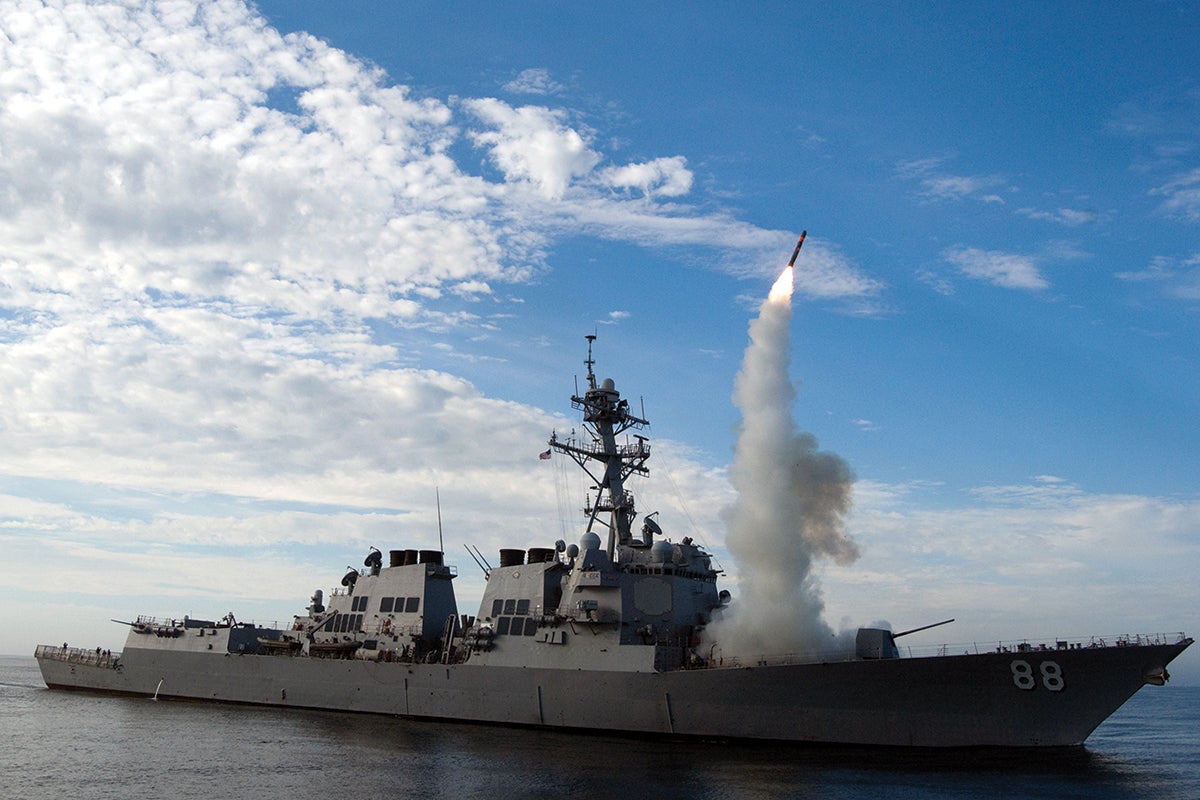 The U.S. Army is also pursuing initiatives to develop ground-launched versions of the Navy Standard Missile (SM)-6 and Tomahawk missiles to engage targets on land and sea at ranges from 500 to 1500 km (U.S. Navy photo by Petty Officer 1st Class Woody Paschall).
The U.S. Army is also pursuing initiatives to develop ground-launched versions of the Navy Standard Missile (SM)-6 and Tomahawk missiles to engage targets on land and sea at ranges from 500 to 1500 km (U.S. Navy photo by Petty Officer 1st Class Woody Paschall).IS THIS A ROLES AND MISSIONS ISSUE OR A CONTEST FOR A BIGGER SLICE OF THE DOD BUDGET?
Since the DoD Key West Agreement of 1948 delineating the functions of the military services—and therefore influencing the corresponding resources and assets allocated to execute those functions—there have been significant changes to: DoD, e.g., the addition of the Space Force and the Goldwater-Nichols legislation; technology, e.g., artificial intelligence and cyber; and the character of warfare, e.g., unmanned vs. manned systems. According to the VCJCS, the joint force will need to work with the new JWC to determine what is feasible before recommending changes to roles and missions. He explains that there is a big difference between having a concept and a finalized plan. The concept helps drive later decisions on programs. Army LRPF is important to the concept, but experimentation, research and analysis are required to demonstrate if it is feasible budgetarily. The concept “is aspiration, not cost-informed. You don’t want it to be.”29
Suggestions that Army pursuit of LRPF is an encroachment on other service missions and resources ignore that the demand for land-based LRPF comes from the COCOMs. There may even be some cost savings associated with LRPF employment; the Wall Street Journal reports that “More American long-range fires—especially if they are portable and ground-launched—can help the balance of power at relatively low cost.”30
WHAT ARE THE CHALLENGES AND CONSIDERATIONS MOVING FORWARD?
While longer range and more precise fires are essential, meaningful capability comes from more than development of cutting-edge systems—it comes from the integration of new weapon systems and software, with appropriate organizational structure, doctrine, linkage to vital ISR and targeting systems and being postured in such a manner as to deliver required effects in competition, crisis and conflict in a timely manner. It also requires affordability of both the systems and the ammunition to enable the force to have sufficient capacity to meaningfully deter or fight. To accelerate this process, the Army has made Project Convergence its principal effort, bringing together many of the key elements of its evolving multi-domain capabilities and concepts in a campaign of learning.
ORGANIZATION
The multi-domain task force (MDTF). As the signature formation in the development of the MDO concept, the MDTF incorporates a Fires Brigade, air defense artillery and a unique organization—the Intelligence, Information, Cyber, Electronic Warfare and Space (I2CEWS) battalion—to converge effects and fires across domains. The Army plans to form five theater-level asset MDTFs—two for USINDOPACOM, and one each for USEUCOM, for the Arctic and for worldwide response.
Theater Fires Command. The Army also plans to develop a theater fires command both in USEUCOM and in USINDOPACOM to control theater long-range fires systems. This headquarters will be key to maintaining momentum in the ongoing process to develop and refine targets to support a land campaign and to help build the multi-national fires team during competition in support of the COCOM.
While there is continuing development within and among these new organizations, the maturing relationship between MDTF, Theater Fires Command and the Combined Air Operations Center promises to enhance the COCOM’s ability to achieve desired effects across all domains. (This would suggest that the establishment of a joint fires command would optimally integrate multi-service and multi-domain capabilities.)
Doctrine. Doctrine is being driven by joint and Army concepts of JADO, JADC2 and MDO—and by lessons learned during experiments and exercises. In addition to the fires component of LRPF, mobility, survivability and logistics considerations will play a significant role in its efficacy. This doctrine and the demands of COCOMs should drive the development and refinements of various joint concepts of operations (CONOPS) to fully exploit the potential of new systems and concepts.
ISR and Targeting. There is much yet to be done on joint and combined ISR, sensing and targeting. How will all of these systems be managed, and what sensors are needed or must be linked to get the right system on target? Integration of service-specific systems and prioritization of sensors and satellites are several of the key issues that should be addressed and informed by JADC2 and enabled by artificial intelligence. In a key effort, the Army is developing the Synchronized High Optempo Targeting (SHOT) fire support application to run on the Tactical Intelligence Targeting Access Node (TITAN) Ground Station. (TITAN leverages space and high-altitude, aerial and terrestrial sensor layers, which provide both targetable data to fires networks and multi-discipline intelligence support to targeting—and they also provide situational awareness and understanding for mission command.31) The Army’s LRPF CFT and its CFT for Assured Position Navigation and Timing are central to strengthening this critical linkage.
Calibrated Force Posture. The Army postures its forces globally through a combination of forward-stationing, rotational presence (in support of DFE) and Army Preposition Stocks. While the Army’s intent would be to have MDTF elements as an “inside force,” already in an adversary’s A2/AD bubble, political, not military, considerations will be the determinant of their location. Permission, and even advocacy, from host nation governments will be necessary, similar to what is required to station heavy bombers there or make a port call.32 Strengthening and expanding alliances, partnerships and status of forces agreements will be important to this ongoing effort.
Congressional Interest. In the FY2020 National Defense Authorization Act (NDAA), Congress directed a DoD report to the House and Senate Armed Services Committees, focused on Army and Marine Corps efforts to develop and deploy ground-based, long-range rocket and cannon artillery to counter land and maritime threats. It required:
An assessment of ongoing and future Army and Marine Corps efforts to develop and deploy ground-based, long-range rocket and cannon artillery to counter land and maritime fires in the AORs of USINDOPACOM and USEUCOM.
An assessment of and recommendations for how DoD can improve the development and deployment of such artillery.
An analysis, assessment and determination of how such artillery employed in support of the United States and allies will be stationed, deployed, operationally-positioned and controlled to operate effectively against potential adversaries throughout the depth of their tactical, operational and strategic formations, including any recommendations of the Secretary of Defense regarding how such capabilities and support could be enhanced.33
The Army’s thorough input to DoD’s response to Congress will be important to ensuring the sustained support and resourcing of this top priority. Neither the Army’s responses nor corresponding congressional actions have yet been released.
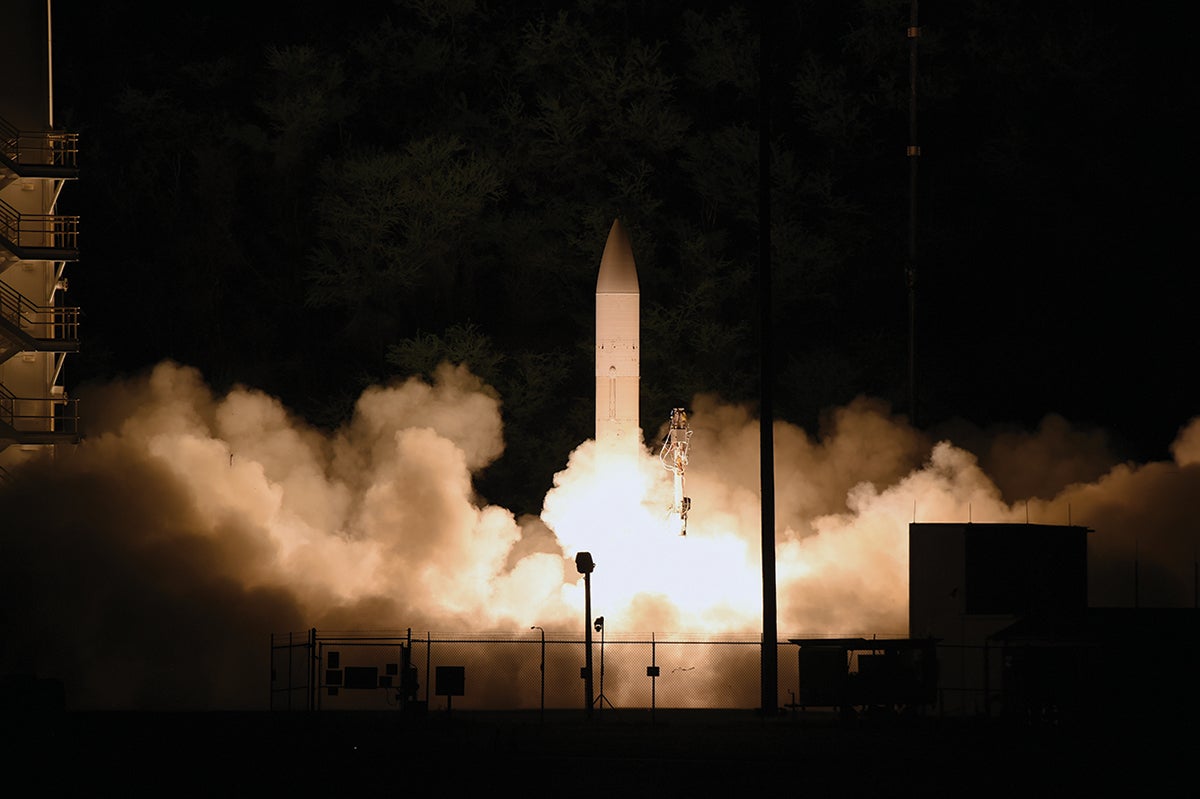 A common hypersonic glide body (C-HGB) launches from the Pacific Missile Range Facility, Kauai, Hawaii, at approximately 10:30 p.m. local time, 19 March 2020, during a DoD flight experiment. The U.S. Navy and U.S. Army jointly executed the launch of the C-HGB, which flew at hypersonic speed to a designated impact point (U.S. Navy photo by Luke Lamborn).
A common hypersonic glide body (C-HGB) launches from the Pacific Missile Range Facility, Kauai, Hawaii, at approximately 10:30 p.m. local time, 19 March 2020, during a DoD flight experiment. The U.S. Navy and U.S. Army jointly executed the launch of the C-HGB, which flew at hypersonic speed to a designated impact point (U.S. Navy photo by Luke Lamborn).THE WAY AHEAD
“The Defense Department needs to think about and prepare for war in a profoundly different way than what we have been accustomed to throughout the better part of the last [20th] century. What is needed is a portfolio of military capabilities with maximum versatility across the widest possible spectrum of conflict.”34
These words could reflect the sentiments of the current U.S. Secretary of Defense, Lloyd J. Austin. In fact, the words are excerpts from then-Secretary of Defense Robert M. Gates’ speech given to the Economic Club of Chicago on 16 July 2009, more than a decade ago. In the 21st century, the U.S. Army has been innovating and continuously improving its ability to operate as part of the joint force while ensuring the ability to dominate in any environment against current, emerging and unforeseen threats. It is investing in modernization priorities as demanded by the COCOMs, and it has a mid- and long-term development plan, which is synchronized with its AimPoint 2035 objectives in support of the NDS.
Land-based LRPF is not a panacea to defeating adversaries’ A2/AD complexes; neither is any other military capability. LRPF, however, can provide COCOMs with the ability to deliver required effects during competition, crisis and conflict by presenting potential adversaries with multiple complementary dilemmas. It is a combat multiplier for the joint force as it counters not only land but also maritime threats. As retired Army General Robert B. Brown, former commander of USARPAC, emphasized when speaking in London on 2 June 2021, MDO will require American military forces to work together for operations involving the land, air, sea, space and cyber domains.35
No comments:
Post a Comment